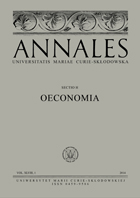Local Debt and the Development of Municipal Infrastructure. The Case of Małopolska
Local Debt and the Development of Municipal Infrastructure. The Case of Małopolska
Author(s): Katarzyna OwsiakSubject(s): Economy, Micro-Economics, Public Finances
Published by: Wydawnictwo Naukowe Uniwersytetu Marii Curie-Sklodowskiej
Keywords: local debt; fiscal rules; local development; local government; local infrastructure
Summary/Abstract: Theoretical background: The contemporary approach to public debt is multi-faceted. Debt incurred to finance current expenses is assessed differently than debt financing capital expenditure. This distinction is also important from the point of view of local authorities as part of their budgetary policy. Each decision related to incurring a debt has not only financial consequences, but is also made in the political and image context. It is worth noting that the current research on debt insufficiently emphasizes its direct impact on the socio-economic development of a given local government unit, devoting much more attention to the impact of debt on the condition of public finances. In the case of the first stream of research, significant discrepancies should be noted with regard to the selection of optimal indicators for measuring the impact of debt on local development. Therefore, one should agree that local development is conditioned by a whole group of factors dependent and independent of local authorities. The article attempts to verify several indicators of the development of infrastructure partially financed with debt.Purpose of the article: Against this background, the subject of this study is to identify the policy of incurring debt by local government units in Poland in the longer term, to determine the degree of diversification of this policy, as well as, and perhaps above all, to link this policy with development processes. In order to avoid a superficial approach to such outlined issues, the scope of observation was limited to the communes of the Małopolska Voivodeship. Such an approach also made it possible to take into account a longer period of observation of the surveyed communes (2010–2020).Research methods: Out of the total number of 179 communes existing in Małopolska, 11 urban communes (the whole group due to their limited number), 20 rural communes and 20 urban-rural communes were randomly selected for the study. The basic criterion for assessing the policy of municipalities in relation to local debt was the ratio of total debt per capita to total revenue per capita. This indicator allows to determine the level of debt burden on communes’ revenue. Next, the total impact of variables characterizing the budgetary policy of the commune was examined, such as: a) own revenue per capita, b) investment expenditure per capita, c) non-recoverable property expenditure per capita (mainly from the European Union), d) debt per capita, on selected indicators of the development of municipal infrastructure of the commune, affecting the quality of life of the commune’s inhabitants. Progress in the development of infrastructure improves the conditions for conducting business activity of private enterprises, including the location of new entities, which may result in an increase in the commune’s own revenue. The study used a multiple correlation coefficient, the value of which was calculated in each distinguished cluster of communes. The obtained results allowed to assess how the level of indebtedness of communes influenced the socio-economic development of these units.Main findings: The conducted analysis made it possible to determine the degree of restrictiveness carried out by the authorities of the analyzed municipalities of Małopolska. The level of the multiple correlation coefficient calculated for municipalities between the explanatory variables characterizing the budgetary policy of municipalities (investment expenditure per capita, debt per capita, non-refundable property expenditure per capita and the dependent variable own revenue per capita) proves a fairly strong relationship between the analyzed variables. On the other hand, in rural communes with a low restrictive budget policy (with a high debt ratio), the total impact of the indicated variables on the level of infrastructure development is generally stronger than in communes with a more disciplined budget policy (with a lower debt level). In the case of urban-rural communes with a low-restrictive budget policy (high debt ratio), the total impact of the analyzed variables on the level of infrastructure development in a commune is generally stronger than in communes with a more disciplined budget policy (with a lower level of debt).
Journal: Annales Universitatis Mariae Curie-Skłodowska, Sectio H Oeconomia
- Issue Year: LVI/2022
- Issue No: 4
- Page Range: 107-133
- Page Count: 27
- Language: English

